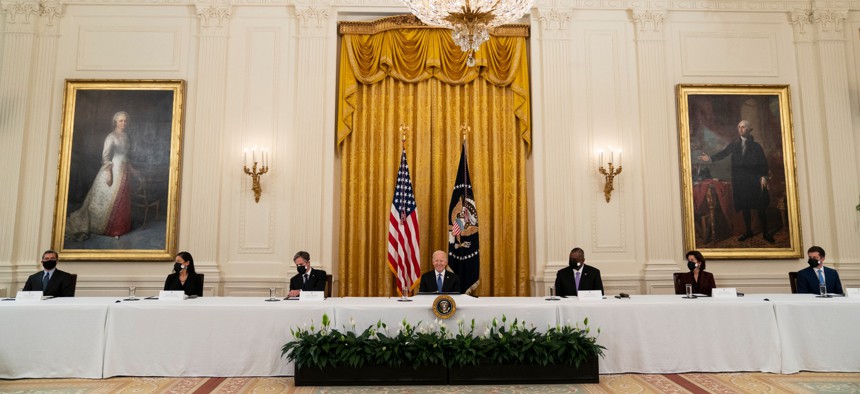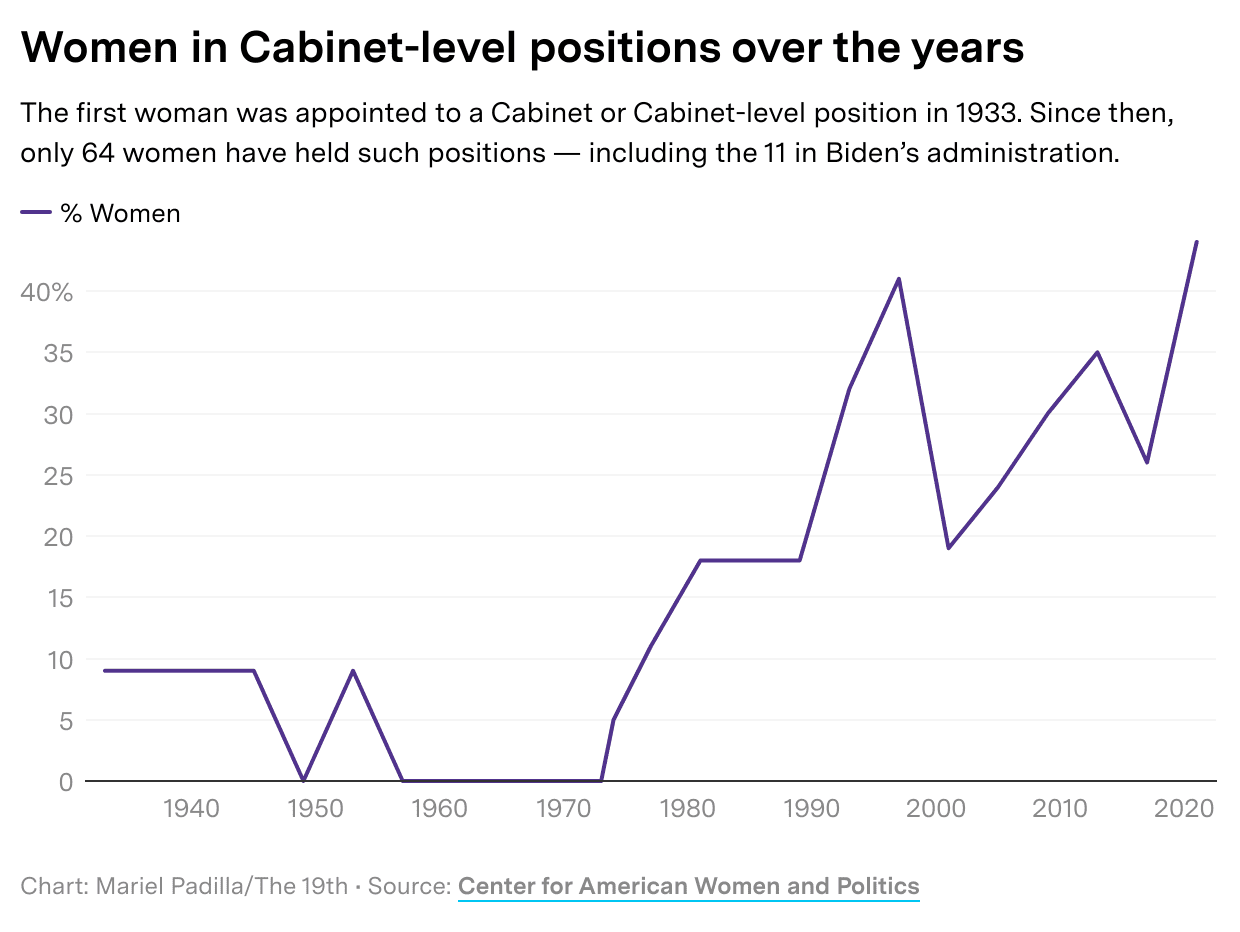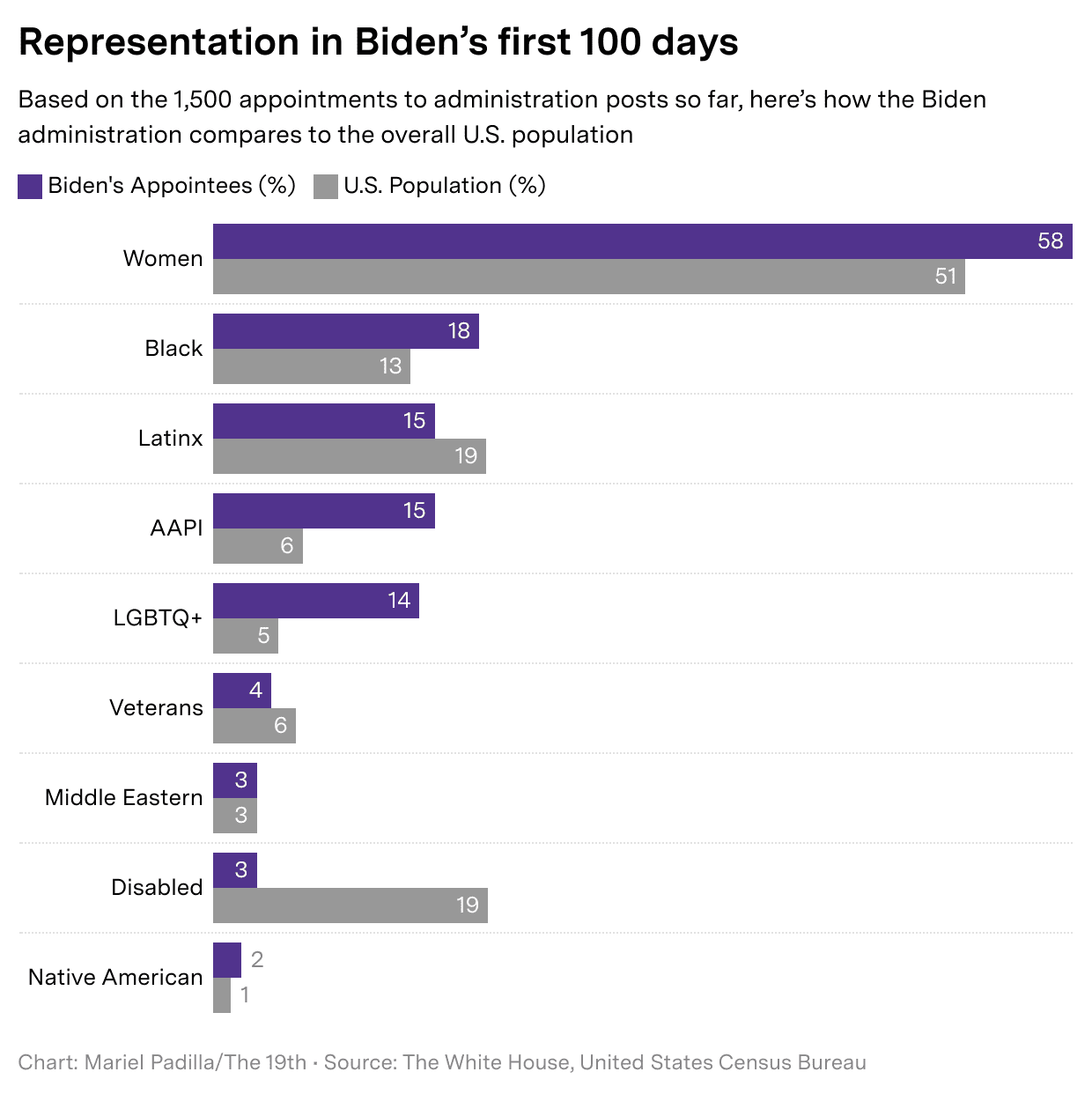
President Joe Biden speaks during a Cabinet meeting in the East Room with, from left, Health and Human Services Secretary Xavier Becerra, Interior Secretary Deb Haaland, Secretary of State Antony Blinken, Biden, Secretary of Defense Lloyd Austin, Commerce Secretary Gina Raimondo, and Transportation Secretary Pete Buttigieg. Evan Vucci/AP
Biden Promised the Most Diverse Administration Ever. Here’s How He’s Doing.
Seven figures that show the representation — and the gaps — in President Joe Biden's Cabinet and federal appointments.
President Joe Biden promised to have a Cabinet that reflected the diversity of the country.
Alongside Kamala Harris, the first woman, Black person and person of South Asian descent to be vice president, Biden said last December before announcing some of his Cabinet nominees: “I promise you, you’ll see the most diverse Cabinet representative of all folks — Asian Americans, African Americans, Latinos, LGBTQ — across the board.”
In addition to the Cabinet, which includes the vice president and the heads of 15 executive departments, presidents fill roughly 4,000 politically appointed positions, including more than 1,200 that must be confirmed by the Senate.
Multiple groups gather data on diversity in the administration. The 19th spoke to experts at the Partnership for Public Service, a nonprofit that provides consulting services to government agencies; the Center for American Women and Politics (CAWP); and Inclusive America, a nonprofit dedicated to government diversity.
According to the Partnership for Public Service, which tracks Biden’s appointees in collaboration with The Washington Post, 41 people had been confirmed by the Senate as of April 29, out of 220 who had been nominated. In comparison, 28 appointees had been confirmed in the Trump administration at the 100-day mark. Former presidents Barack Obama and George W. Bush had 67 and 34, respectively.
Here’s where the Biden administration stands after 100 days in office:
58 percent of Biden’s agency appointees are women.
Kristine Simmons, the vice president of government affairs at the Partnership for Public Service, said Biden is the first president in modern history to appoint more women than men in his first 100 days.
Of the 1,500 agency appointees thus far, about 58 percent are women, according to the White House.
Kelly Dittmar, director of research at the Center for American Women and Politics, said about 44 percent of the 25 Cabinet and Cabinet-level senior positions, including the vice presidency, are held by women, the highest level for any president. The first woman to be appointed to a Cabinet or Cabinet-level position was Frances Perkins, named secretary of labor in 1933. Since then, only 64 women have held such positions — including the 11 in Biden’s administration.

The administration has at least 16 high-level “firsts.”
More than a dozen of Biden’s chosen leaders are breaking new ground, the first in their community to hold a position.
- Kamala Harris is the first woman, Black person and person of South Asian descent to be vice president
- Janet Yellen is the first woman to be secretary of the treasury
- Deb Haaland, the secretary of the interior, is the first Native American to serve as a Cabinet secretary
- Cecilia Rouse is the first woman of color to chair the Council of Economic Advisors
- Katherine Tai is the first woman of color to serve as U.S. trade representative
- Avril Haines is the first woman to lead the U.S. intelligence community
- Wendy Sherman is the first woman to serve as Deputy Secretary of State
- Kathleen Hicks is the first woman to serve as Deputy Secretary of Defense
- Karine Jean-Pierre is the first openly lesbian person to serve as the vice presidential chief of staff
- Rachel Levine is the first openly transgender person to be confirmed by the Senate
- Pete Buttigieg is the first openly LGBTQ+ person to serve in the Cabinet
- Lloyd Austin is the first Black secretary of defense
- Alejandro Mayorkas is the first Latino and immigrant to serve as secretary of homeland security
- Xavier Becerra is the first Latino to serve as secretary of health and human services
- Wally Adeyamo is the first Black man to serve as Deputy Secretary of the Treasury
- For the first time, the communications team is comprised of all women
Prior to this administration, President Bill Clinton had the most diverse Cabinet when it comes to race and gender, according to Suzanne Chod, a professor of political science at North Central College in Illinois.
Biden has been delegating quite a bit of responsibility to Harris and the Cabinet secretaries — giving them “real authority,” Chod said.
“It’s not just enough to have someone in the literal room where decisions are made,” Chod said. “It’s about that person’s voice being equal to everyone else in the room.”
Historically, one of the challenges to increasing diversity has been a reluctance to make commitments along lines of identity, Dittmar said. Presidential candidates feared they would open themselves up for false accusations of choosing people based on demographics instead of merit. In fact, women and people of color tend to have greater qualifications because the bar is often higher, she said.

For the first time in two decades, there is no Asian American Cabinet secretary.
Mark Hanis, co-founder of Inclusive America, said that for the first time in decades, there is no Asian American or Pacific Islander Cabinet secretary.
The statutory Cabinet includes the vice president and the leaders of 15 executive departments. Biden has designated nine other officials as part of the Cabinet. One is Tai, the U.S. trade representative and only Asian American in a Cabinet-level position. Neera Tanden, a South Asian American, was also poised to land a Cabinet-level position until Senate opposition sank her nomination to lead the Office of Management and Budget.
About 15 percent of Biden’s total agency appointees identify as AAPI — more than double the percentage of Asian Americans in the total U.S. population.
About 15 percent of appointees identify as Latinx.
According to the White House, 15 percent of Biden’s 1,500 hired appointees identify as Latinx, while they account for nearly 19 percent of the total U.S. population.
However, there is a gap in Latinx representation in senior positions, Hanis said. Only 3.8 percent of deputy secretaries and no chiefs of staff identify as Latinx.
Only 3 percent of appointees identify as disabled or having a disability.
Hanis said the biggest diversity gap he has seen is the representation of people with disabilities. About 1 in 4 Americans live with a disability, he said, and yet only 3 percent of all appointees identify as disabled.
When it comes to leadership, the disparity is wider. Hanis said he is not aware of any senior officials that have disabilities.
About 48 percent of Cabinet-level officials attended an Ivy League school.
Nearly half of the current Cabinet-level officials have attended an Ivy League school, according to data compiled by Inclusive America. Twelve of the 25 Cabinet and Cabinet-level officials went to Harvard, Yale, University of Pennsylvania or Princeton.
Diversity goes beyond demographic identity, Dittmar said. True representation is more directly tied to different lived experiences.
“Having everybody come from Harvard or come from a wealthier, privileged background is problematic even if it is 50/50 women and men,” Dittmar said.
The White House says it has set a record on getting people into administration jobs.
The White House says that it has appointed nearly 1,500 people who don’t need to be confirmed by the Senate and that more than half are women and half identify as non-White.
The goal is to get parity at every level of government.
“I think there’s a way to do it if you’re intentional,” Hanis said. “That’s a big mantra with those of us in the diversity, equity and inclusion space. It doesn’t just happen.”
Too often, people are chosen based on their networks, Dittmar said. It’s important that there is an access and pipeline to these powerful positions for minority groups.
“Diversity begets diversity,” Dittmar said.
Chod said this is the largest effort she’s seen to have a diverse administration — a push that is long overdue and must continue.
“We have to go back to the root of the inequity,” Chod said. “… It can’t just be a band-aid fix. We have to get to the root of it and open up that wound.”
Originally published by The 19th






